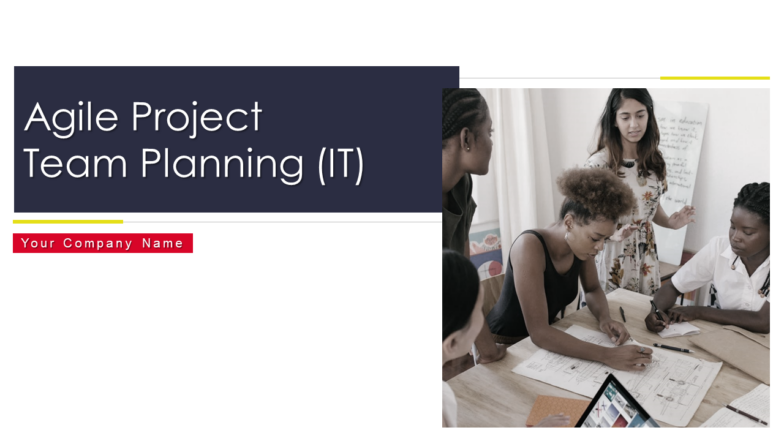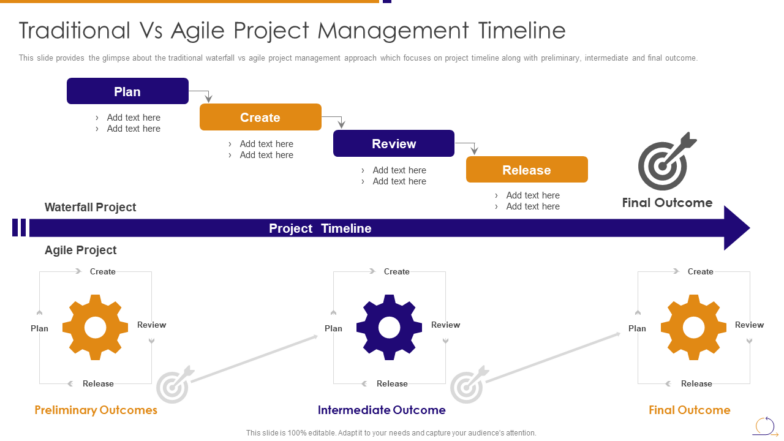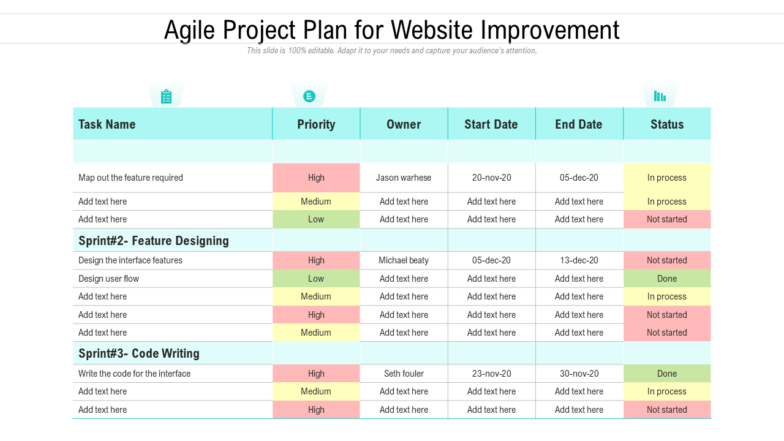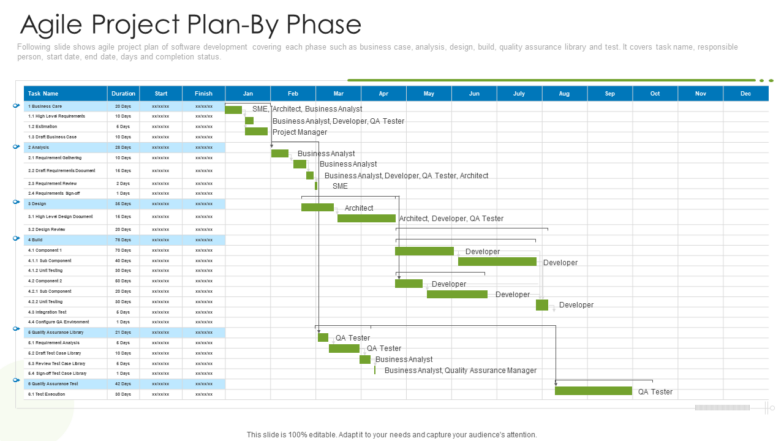Thinking is no substitute for information. You may think all day, but will never be able to answer a question on the local airport timetable if you do not have the schedule with you. The key to resolving this fight between thought and information is to get more organized and be fluid in your thought patterns. For IT businesses, being fluid translates into being more agile with software project plans.
The agile methodology has come to define most software creation today. This project plan philosophy relies on iterative, short bursts of work that create a wow product, meeting all end-user specifications.
Do you know that seven of 10 US companies use Agile? And after adopting Agile, companies experienced an average of 60% growth in revenue and profit. Click here to access the top 5 agile project roadmap templates that allow businesses to deliver results efficiently.
At SlideTeam, we understand businesses' pain points in finding reliable, very nearly off-the-shelf presentation templates to get acquainted and start implementing an Agile Project Plan in their solutions to clients. These PPT Templates give you the procedure, tools, resources, and execution mantras to master Agile project plans.
Moreover, the content-ready templates give you the desired structure and a point from which to start. The 100% editable and customizable feature allows you to customize your message to your target audience.
Let's explore and enjoy a study of these presentation templates.
Template 1: Agile Project Team Planning IT PowerPoint Presentation Slides
This complete deck on agile projects covers 14 major practical points related to the practical implementation of software works. The course touches on all required reading, such as demonstrating the needed information. One of the opening slides shows the owner of the project, status, priorities, type deadlines, and estimated time and actual time for the work. The resource allocation sheet is also covered, and the format also records the project's start and end date. An agile team plan’s breakdown into the sprints, such as impact analysis, design and build, testing, infrastructure, and change management, also gets a separate slide. Use this PPT Set to address concerns over agile product team productivity, user stories, etc. For project releases, businesses can refer to the team planning segment. Download now to help clients create unparalleled efficiencies.
Template 2: Agile Project Management Framework Agile Managing Plan
This PowerPoint Slide provides a glimpse into an agile project management framework involving initiation, construction, delivery, maintenance, and support phases. The PPT Layout is brilliant in that it provides the user base across each of these linear phases. For instance, the project initiation phase has the office project team as the lead players. In the construct and deliver phase, the development team gets involved to decide on the business model, prepare a product prototype and assess and release the project. The maintenance and support team helps identify defects and enhancements. During the first half of this entire framework, the show belongs to the user expert, while the end-users make an entry for the delivery phase and the maintenance phase. The key competencies this project requires are also mentioned. Download now to find out what these are!
Template 3: Traditional versus Agile Project Management Timeline
What makes Agile Projects so unique? This presentation template provides the answer in a wonderfully creative way by juxtaposing the processes. Traditional projects focus on the four linear steps of Plan, Create, Review, and Release, to arrive at the lone outcome. Such conventional approaches are also compared to waterfalls named the Waterfall Project. However, no one is concerned about the final result in an Agile Project Management Timeline. Even though the steps of the planning chart remain the same, there is a preliminary outcome, an intermediary outcome, and the outcome associated with the Agile Methodology. This iterative, willing-to-learn-at-every-step approach characterizes the agile roadmap. This presentation layout captures the difference beautifully. Download now to make this yours and wow your audience.
Template 4: Agile Project Milestones and Backlogs Planning
Project managers know in their bones that planning well is organizing well, as resources fall into place once they have put in the hard yards to achieve milestones and clear backlogs. This PPT Template studies the project cycle to record milestones and prepares to tackle backlogs that businesses might have missed initially. Each milestone is mapped to how important it is and then put on a priority type. The PowerPoint Layout also maps backlogs similarly but in a different color scheme. The gaps that managements have to bridge for each of these tasks are also there; this helps close these faster and execute quicker. Download this template now to create that urgency to achieve that significant milestone.
Template 5: Agile iteration Planning Agile Project Management Frameworks
Iteration Planning gives the Agile Framework its distinct flavor of being so effective. Agile projects are not very different from ordinary, standard projects without iterations. Use this PPT Presentation Template to track the status of your iterations on parameters like the owner, status, priority, type, deadline, etc. The gap between the estimated and actual time taken is an important parameter. The typical 1st iteration is carried out in weeks 1-2, with the second iteration carried out in weeks 3-4. The slide also helps you know the status in a concise and precise couple of words, like waiting for deployment, ready for development, and needs product. Download this template to create a world of precise, organized plans with everything in place.
Template 6: Agile Project Management Approach Plan
Divided into eight columns, this PPT Template resolves the pain point of businesses' failure to maintain a record of tasks implemented under an Agile Project Management methodology. The task name (sprints in the technique) is tabulated against the person responsible, the state and finish dates, the day's duration, the project status, and comments. Then, we list the features each sprint provides and decide whether adding the functionality comes with a risk factor. If you get this table right after downloading this template, you will understand why the agile methodology is so highly-rated. Get this presentation template now!
Template 7: Agile Project Sprint Rollout Plan Framework
The actionable PPT Template on an agile project sprint rollout allows you to showcase how you have mastered the complexities of this project management. The 3x5 grid design represents actions under each sprint and the corresponding implementation tools under each stage. The Sprints sit in the middle row and are numbered for Sprint 0 to the Final Sprint. The actions this template recommends in each sprint are documented (though these are 100% customizable, this fact merits reiteration, even as the cost of repetition). In Sprint 0, for instance, the actions are kick-off, setting up the environment. The corresponding implementation tools in Sprint 0 have to be product owner training. Then, once the grid is complete, you can only marvel at the time the presentation template has saved for you! Get this PPT Slidenow and start the rollout of your agile software-making plan.
Template 8: Agile Project Plan for Website Improvement
This innovatively-designed presentation template makes remarkably creative use of the agile project methodology. It can make you the master of website upgrades or improvement if you get the table right here. Starting with the first column of task names, we highlight these as the three major ones of Sprint 1 Requirement Planning, Feature Designing in Sprint 2, and Code Writing in Sprint 3. The subheads under the three are linked to color-coded priority legends as High, Medium, and Low. The owner, the start and end dates, and the status help you track the minutest of tasks. This simple plan lets you make sense of your website improvement plan and decide on its efficacy and effectiveness. Download this PPT Set now to set an example for the most improved website created through the minimum resource spend.
Template 9: Monthly Agile Project Plan
This monthly agile project plan slide covers activities such as planning, configuring multilingual features, testing, and deploying resources. For convenience, the month has been taken as having 30 days in the slide (you can customize it, of course). The concept guiding this PPT Layout is that hours and days are essential to sprint planning, and if done in this wonderfully organized way, businesses can complete most agile projects in a month. Track progress and project dependencies using color codes, with the strips also indicating the start and end dates. As always, the owner column is also critical to ensuring accountability. Download now!
Template 10: Agile Project Plan by Phase Agile Project Management with Scrum PPT Graphics
This presentation template marries the five significant processes in business software development to the agile methodology of organizing things. The five stages of evaluating whether a business case exists, then analysis of the scenarios, designing a system, building a quality assurance library, and testing, all require unique and professionally-inculcated competencies. Use this PPT Preset to document all this and more, with the hierarchy levels highlighted to ensure people know their roles according to phase-wise project categorization. Get this presentation template now with a download. Ensure business process and agile sit comfortably with each other.
AGILITY AS AN ADVANTAGE
Agile projects draw their strength from their ability to stay flexible and bank on iterations than any sole, one-dimensional outcome. In that sense, they mirror life where no single event can cloud the direction of your life, though massive events will keep happening around us. Hence, agile software projects give you a massive advantage that follow the linear route, with no room for iterations.
If for some reason, agile project plans do not fit into your specific projects, IT project plans are the answer. Access the best templates on IT project management with a click here.
P.S. It is empirically proven that diversity, inclusion, and equity are well-accepted ways to be more sensitive to business opportunities. A corporation that embraces diversity also saves itself from the toxic effects of bias. SlideTeam offers a comprehensive hands-on course on diversity and inclusion that helps organizations shine as positive beacons, while improving their profits as well, Click here to access this complete guide to diversity and inclusion training, with training material included (Free PDF also attached)
P.P.S. If you are into healthcare business development, you need to make a strong case for the model you foresee working. Experience will bear out that investors are still active in this space. SlideTeam offers you Top 10 Must-Have Healthcare Pitch Decks that ease your job. Explore best-in-class SlideTeam templates to create a splash in the healthcare business with a click here.
FAQs on Agile Project Plans
How do you write an Agile plan?
Agile Planning is a project planning approach that forecasts work, using self-contained work units called iterations or sprints. Writing an agile plan first entails the identification of release (something we call goals). When writing an agile technique, the release means developing a new product or significantly upgrading a current one. Teams can break down each release into many versions, also called sprints. Each sprint, usually two weeks, has this set duration. The team has a predefined set of work items for each sprint. The objects in work are called user tales.
Is the project plan used in Agile?
It is clear and self-evident that a project plan is an integral part of agile methodology. It does not, however, follow the strict structure associated with a project plan. Yet, the project plan is a part of agile, though in a highly flexible way. This is because an agile project has the added advantage of being adaptive and highly responsive to changes. The structure encourages businesses to do without following any format. Technically, agile also documents in some detail only the initial sprint. The rest of these sprints are, perforce, based on the performance of the first sprint.
What are the three stages of Agile Planning?
The three stages of Agile Planning are simplifying goals into doable tasks for teams, whether in discussions or actual execution. The second stage is holding scrum meetings, a uniquely Agile planning concept. A scrum is a daily happening in a sprint, where teams adopt an innovative discussion pattern under a scrum master. It is an everyday occurrence but always appears fresh due to the ideas and tasks discussed. The third stage of agile Planning always focuses on productivity and deadlines, ensuring that sprints are meaningful and sticking to the standard two-week deadline.
What are the five levels of Agile Planning?
There are levels in agile Planning that ensure that sprints and scrums lead to meaningful achievement. The five levels are:
- Vision
- Release
- Iteration
- Road map
- Daily Planning.
These levels are all well thought out, with executive involvement being very heavy in vision, which consciously defines project goals to team members. It is not likely to be updated once set, as it helps the team focus on critical aspects. Then, the roadmap is a high-level plan to achieve product vision incrementally, and businesses also use it as a communication tool for shareholders. Then, the sprint teams decide on the other three release levels (business goals), iteration, and daily planning steps. These require minimal executive or top management intervention; teams update these frequently.





 Customer Reviews
Customer Reviews



























